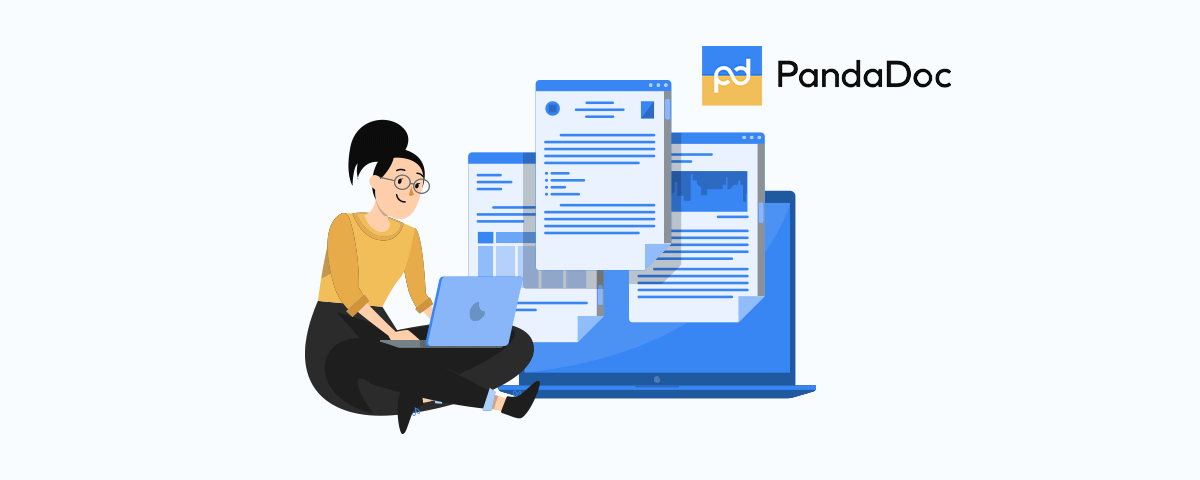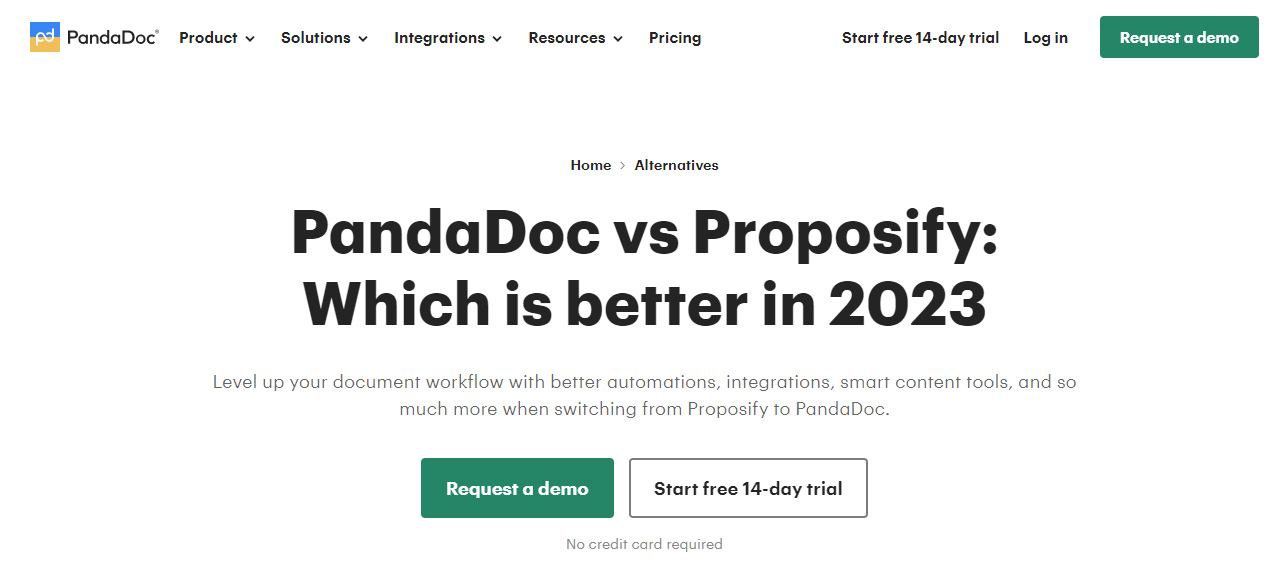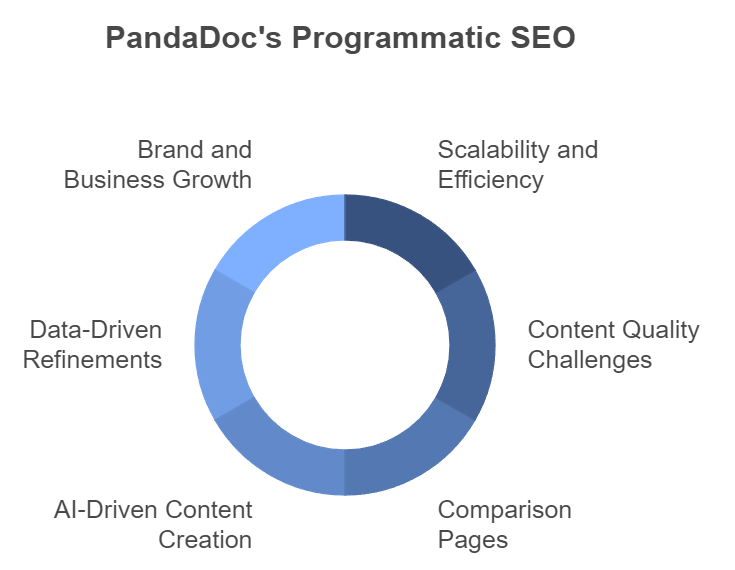Listen to this story
Overview of PandaDoc
PandaDoc is a leading all-in-one document automation and e-signature solution, empowering businesses of all sizes to streamline their document workflows. As a rapidly growing SaaS company, PandaDoc has established a strong online presence through its strategic implementation of programmatic SEO.
A brief overview of PandaDoc’s programmatic SEO strategy
At the core of PandaDoc’s digital success lies its innovative programmatic SEO approach. By integrating advanced AI and machine learning technologies, PandaDoc has been able to automate and optimize its entire SEO process, from content creation to technical on-page optimization and beyond.
Key elements of PandaDoc’s programmatic SEO strategy include:
Intelligent Content Generation: PandaDoc’s content team collaborates with their programmatic SEO platform to identify high-intent keywords, analyze user search patterns, and produce relevant, search-optimized content at scale.
Automated On-Page Optimization: PandaDoc’s programmatic system continuously monitors their website’s content, metadata, and infrastructure, making real-time adjustments to maximize search visibility.
Sophisticated Link Building: Through data-driven prospecting and outreach, PandaDoc has built a robust, contextually relevant backlink profile, strengthening their domain authority.
Predictive Performance Modeling: PandaDoc’s programmatic platform utilizes advanced analytics and machine learning to forecast the impact of SEO initiatives, enabling data-driven decision-making.
Continuous Monitoring and Optimization: PandaDoc’s SEO team works closely with the programmatic system to track metrics, identify areas for improvement, and refine their strategies on an ongoing basis.
Segregation of traffic numbers behind PandaDoc’s programmatic SEO strategy
- Direct: 75.8% (5.1M)
- Organic Search: 10.33% (692.4K)
Direct Traffic (75.8% – 5.1M): The substantial share of direct traffic, accounting for 75.8% of PandaDoc’s total website visits, suggests a strong brand recognition and customer loyalty. This direct traffic is likely driven by PandaDoc’s consistent branding efforts, targeted advertising, and the ability to convert leads through their sales and marketing channels.
Organic Search Traffic (10.33% – 692.4K): The 10.33% of organic search traffic, translating to over 692,400 monthly visits, is a testament to the power of PandaDoc’s programmatic SEO strategy. By leveraging advanced AI and machine learning algorithms to optimize their content, technical infrastructure, and off-page factors, PandaDoc has been able to significantly improve their visibility and ranking in search engine results.
This organic search traffic represents a highly valuable segment of PandaDoc’s audience, as these users are actively searching for and engaging with PandaDoc’s solutions, indicating a high level of intent and likelihood of conversion.
Detailed PandaDoc programmatic SEO strategy
853.7K+ monthly organic traffic
4K+ pages indexed on Google
PandaDoc vs {Software}: Features, Pros, Pricing
- PandaDoc vs DocuSign 2024: Features, Pros, Pricing
- PandaDoc vs Acrobat Sign Comparison: Features, Pricing
{Industry} Document Management and Workflow Automation Software
- Construction Document Management and Workflow Software
- Manufacturing Document Management and Workflow Automation Software
- Legal Document Management and Workflow Automation Software
A Deep Dive into the Structure of PandaDoc Pages/Section
Comparison Pages
Data Points
- Title of the page
- Description
- CTA
- Comparison between the two
- More information and features about PandaDoc
Industry Pages
Data Points
- Title of the page
- Description of page
- CTA
- Features & Benefits of PandaDoc
- Testimonials
- CTA
Enhancing Digital Strategy: PandaDoc’s Programmatic SEO Insights
Advantages and Challenges in Programmatic SEO
Implementing programmatic SEO offers significant advantages such as scalability and efficiency for a business like PandaDoc, which deals with vast content needs. However, challenges include maintaining content quality and managing the potential for SEO penalties due to content duplication.
Impact of Comparison Pages
PandaDoc’s comparison pages are a strategic component of their programmatic SEO efforts, targeting specific user queries with detailed, comparative content that improves engagement and increases page authority.
AI-Driven Content Creation
AI and machine learning revolutionize content creation at PandaDoc by enabling automated, data-driven content that aligns closely with user intent, differing from traditional methods that require more manual effort and intuition.
Data-Driven SEO Refinements
PandaDoc utilizes data and analytics to continuously refine its SEO strategy, employing user behavior analytics and search trend data to optimize existing content and generate new topics that resonate with their audience.
Brand and Business Growth Impact
Programmatic SEO significantly contributes to PandaDoc’s brand awareness and customer acquisition, driving targeted traffic that leads to higher conversion rates and business growth.
Build a programmatic SEO Strategy with uG
PandaDoc is a leading document automation and eSignature platform that helps businesses streamline their sales and contract management processes. As a growth marketing agency, upGrowth can partner with PandaDoc to build a powerful programmatic SEO strategy that drives sustainable, long-term growth for the business.
Tired of the endless struggle to rank your website and drive organic traffic? Look no further! upGrowth’s Programmatic SEO Strategy is the answer to your growth woes. Our data-driven approach leverages the power of automation and deep analysis to revolutionize your SEO efforts. Here’s how we can take your online presence to new heights. Contact us today to learn more about our custom-tailored solutions and how we can help your PandaDoc business thrive in the digital landscape.
Watch Now: How PandaDoc Programmatic SEO Delivers 853.7K+ Monthly Organic Traffic
Glossary of Key Terms
- Programmatic SEO: A scalable SEO strategy that uses automation and data-driven insights to optimize a large volume of pages for long-tail keywords and niche queries.
- Direct Traffic: Website traffic from users who directly enter the website URL or click a bookmark, indicating brand awareness and loyalty.
- Organic Search Traffic: Website traffic from users who find the website through search engine results pages (SERPs).
- AI (Artificial Intelligence): The simulation of human intelligence processes by computer systems, enabling tasks like data analysis, pattern recognition, and decision-making.
- Machine Learning: A subset of AI that allows computer systems to learn and improve from data without explicit programming.
- Long-Tail Keywords: Longer and more specific keyword phrases that target a niche audience.
- Domain Authority: A metric that predicts how well a website will rank on search engine result pages (SERPs).
- On-Page Optimization: Optimizing elements on a website page to improve its ranking for specific keywords.
- Off-Page Optimization: Activities performed outside of a website to improve its ranking, such as link building.
- Backlink Profile: The collection of links pointing to a particular website, influencing its domain authority.
- Call to Action (CTA): A prompt on a web page that encourages users to take a specific action, such as signing up for a newsletter or purchasing a product.
Segregation of traffic numbers behind PandaDoc’s programmatic SEO strategy
- Direct: 75.8% (5.1M)
- Organic Search: 10.33% (692.4K)
Direct Traffic (75.8% – 5.1M): The substantial share of direct traffic, accounting for 75.8% of PandaDoc’s total website visits, suggests a strong brand recognition and customer loyalty. This direct traffic is likely driven by PandaDoc’s consistent branding efforts, targeted advertising, and the ability to convert leads through their sales and marketing channels.
Organic Search Traffic (10.33% – 692.4K): The 10.33% of organic search traffic, translating to over 692,400 monthly visits, is a testament to the power of PandaDoc’s programmatic SEO strategy. By leveraging advanced AI and machine learning algorithms to optimize their content, technical infrastructure, and off-page factors, PandaDoc has been able to significantly improve their visibility and ranking in search engine results.
This organic search traffic represents a highly valuable segment of PandaDoc’s audience, as these users are actively searching for and engaging with PandaDoc’s solutions, indicating a high level of intent and likelihood of conversion.
Detailed PandaDoc programmatic SEO strategy
853.7K+ monthly organic traffic
4K+ pages indexed on Google
PandaDoc vs {Software}: Features, Pros, Pricing
- PandaDoc vs DocuSign 2024: Features, Pros, Pricing
- PandaDoc vs Acrobat Sign Comparison: Features, Pricing
{Industry} Document Management and Workflow Automation Software
- Construction Document Management and Workflow Software
- Manufacturing Document Management and Workflow Automation Software
- Legal Document Management and Workflow Automation Software
A Deep Dive into the Structure of PandaDoc Pages/Section
Comparison Pages
Data Points
- Title of the page
- Description
- CTA
- Comparison between the two
- More information and features about PandaDoc
Industry Pages
Data Points
- Title of the page
- Description of page
- CTA
- Features & Benefits of PandaDoc
- Testimonials
- CTA
Enhancing Digital Strategy: PandaDoc’s Programmatic SEO Insights
Advantages and Challenges in Programmatic SEO
Implementing programmatic SEO offers significant advantages such as scalability and efficiency for a business like PandaDoc, which deals with vast content needs. However, challenges include maintaining content quality and managing the potential for SEO penalties due to content duplication.
Impact of Comparison Pages
PandaDoc’s comparison pages are a strategic component of their programmatic SEO efforts, targeting specific user queries with detailed, comparative content that improves engagement and increases page authority.
AI-Driven Content Creation
AI and machine learning revolutionize content creation at PandaDoc by enabling automated, data-driven content that aligns closely with user intent, differing from traditional methods that require more manual effort and intuition.
Data-Driven SEO Refinements
PandaDoc utilizes data and analytics to continuously refine its SEO strategy, employing user behavior analytics and search trend data to optimize existing content and generate new topics that resonate with their audience.
Brand and Business Growth Impact
Programmatic SEO significantly contributes to PandaDoc’s brand awareness and customer acquisition, driving targeted traffic that leads to higher conversion rates and business growth.
Build a programmatic SEO Strategy with uG
PandaDoc is a leading document automation and eSignature platform that helps businesses streamline their sales and contract management processes. As a growth marketing agency, upGrowth can partner with PandaDoc to build a powerful programmatic SEO strategy that drives sustainable, long-term growth for the business.
Tired of the endless struggle to rank your website and drive organic traffic? Look no further! upGrowth’s Programmatic SEO Strategy is the answer to your growth woes. Our data-driven approach leverages the power of automation and deep analysis to revolutionize your SEO efforts. Here’s how we can take your online presence to new heights. Contact us today to learn more about our custom-tailored solutions and how we can help your PandaDoc business thrive in the digital landscape.
Watch Now: How PandaDoc Programmatic SEO Delivers 853.7K+ Monthly Organic Traffic
Glossary of Key Terms
- Programmatic SEO: A scalable SEO strategy that uses automation and data-driven insights to optimize a large volume of pages for long-tail keywords and niche queries.
- Direct Traffic: Website traffic from users who directly enter the website URL or click a bookmark, indicating brand awareness and loyalty.
- Organic Search Traffic: Website traffic from users who find the website through search engine results pages (SERPs).
- AI (Artificial Intelligence): The simulation of human intelligence processes by computer systems, enabling tasks like data analysis, pattern recognition, and decision-making.
- Machine Learning: A subset of AI that allows computer systems to learn and improve from data without explicit programming.
- Long-Tail Keywords: Longer and more specific keyword phrases that target a niche audience.
- Domain Authority: A metric that predicts how well a website will rank on search engine result pages (SERPs).
- On-Page Optimization: Optimizing elements on a website page to improve its ranking for specific keywords.
- Off-Page Optimization: Activities performed outside of a website to improve its ranking, such as link building.
- Backlink Profile: The collection of links pointing to a particular website, influencing its domain authority.
- Call to Action (CTA): A prompt on a web page that encourages users to take a specific action, such as signing up for a newsletter or purchasing a product.








